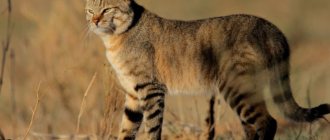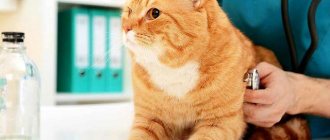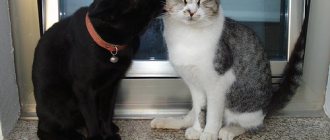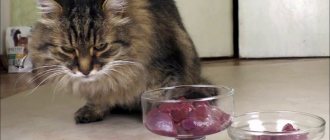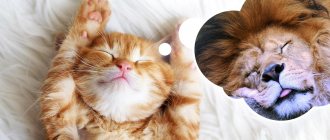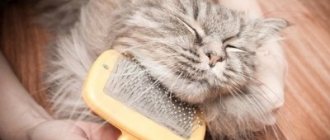Salary as of 10/19/2020Important qualitiesWhere to study
From lat. felinus - feline and other Greek. logos - word, teaching. The profession is suitable for those who are interested in biology (see choosing a profession based on interest in school subjects). In 2020, the ProfGid career guidance center developed an accurate career guidance test. He himself will tell you which professions are suitable for you, and give an opinion about your personality type and intelligence.
A felinologist is a specialist in domestic cats.
Features of the profession
Felinology is a branch of zoology. Many people love cats and know how to care for them. But first of all, the word “felinologist” means owners of catteries (breeders), leaders of purebred cat clubs and, of course, experts working at cat shows.
An ordinary owner of a cat with a good pedigree can become a breeder.
The head of the nursery is, in theory, a specialist in the breeding and selection of cats.
An expert felinologist is an expert in cat breed standards.
Also, felinologists include specialists in the pet industry who produce food, vitamins for cats and care products for them (shampoos, medications, etc.).
Initially, cats were assigned the role of protectors of the house from mice and rats. And many of them are still doing this successfully, and not only in villages. For example, mustachioed guards protect Hermitage exhibits from rodents. The mousecatcher watches over the peace of the British Prime Minister at his residence on Downing Street.
However, most modern domestic cats, both purebred and mongrel, have never seen a mouse. Their main role is to delight their owners with their presence.
So, unlike dogs, the role of cats in the national economy is small. But the more purebred the cat, the more promising it is for an exhibition career. Many cat lovers are actively involved in the exhibition “game”: they show off their cats and collect diplomas.
Success requires a cat that meets the standards with a good pedigree and a competent judge. The higher a cat’s ratings at various shows, the more promising it is for breeding. And the higher the reputation of the breeder who raised her. The higher the reputation, the more valuable the kittens from his cat (or cats).
On the other hand, a certified show judge is constantly under the close attention of breeders and ambitious owners of participating cats. Every owner knows perfectly well the breed standards of his pet, and an expert has no right to make mistakes.
In a word, this is a system of mutual regulation. However, can felinology be called a profession? Opinions differ on this issue.
Hobby or profession?
In terms of the amount of labor invested, this is undoubtedly a profession.
For example, an expert felinologist (felinologist judge) must know in detail the characteristics of the breeds that he judges. The right to judge at exhibitions is given by a license. To get it, you need to have experience as a breeder and take many paid courses. Moreover, different breeds require separate training and licenses.
Breed standards are developed by the World Cat Federation (WCF). They describe in detail the characteristics (articles) of the breeds: features of the head, ears, body, paws, tail, coat. A point scale is given for each article. The felinologist judge must be well aware of these standards.
But, as the experts themselves say, you cannot live on the fees of a felinologist judge. “Payment for refereeing is not the most important part of our work,” they explain.
Therefore, a felinologist expert is most often an additional profession that can develop into a hobby.
At the same time, as Danish expert felinologist of international category Thomas Andersen says, the work of an expert felinologist opens up new horizons for a person: “I had been breeding cats for 15 years, when I suddenly realized that with such experience you can not only take care of your cats, but and judge others. No sooner said than done. I went to study. Then, when I started working as a judge, I discovered so many joys that I didn’t even know about! For example, the opportunity to travel. Experts travel around the world for free, and I like to say that my cats “carry me around.” (Magazine "Friend")
Breeding cats can bring significant income . Therefore, every year the number of people opening their own nurseries, clubs and associations is growing.
This is already animal husbandry (the so-called unproductive animal husbandry, which also includes cynology). But as already said, the breeder’s income depends on the quality of the kittens and the demand for them. And also from the inevitable overhead costs associated with the purchase and maintenance of breeding kittens.
The problem with this business is also that the higher the demand for the breed, the higher the competition. At the same time, breed fashion is changing, and this also affects commercial success.
The second problem is lack of knowledge. It is obvious if breeding work is carried out by yesterday's amateur. Pedigree breeding requires serious preparation.
A felinologist with a higher education who has graduated from the zootechnical or veterinary faculty can advise amateur felinologists. At the same time, he can head a club of any breed or association.
Who studies cats?
As a professional activity, felinology has existed since the second half of the 19th century. It was during this period that communities of cat lovers began to appear in Great Britain, which later merged into a single organization, the Governing Council of the Cat Fancy (GCCF), focused on exhibition activities and standardization of animal breeds. Solving the problems facing the club members required specific knowledge. This is how felinologists appeared - specialists with a narrow focus who study such aspects of working with cats as:
- animal breeding;
- selection;
- development of products for pets (food, cosmetics, safe toys, etc.);
- supervision of factory circles and events held by them (exhibitions, etc.);
- training future colleagues - experts in the considered areas of activity.
Regardless of their profile, such specialists united in special organizations. Among the most respected felinological societies around the world, functioning to this day, are:
- The Governing Council of the Cat Fancy (GCCF);
- Federation International Feline (FIFe);
- World Cat Federation (WCF);
- The Cat Fanciers Association (CFA);
- The Cat Fanciers Federation (CFF);
- The International Cat Association (TICA);
- International Felinological Association (IFA) registered in Russia;
- International Cat Union (ICU);
- World Association of Cat Clubs (WACC);
- Alliance SuperCats (ASC).
Today, the tasks facing the participants of these clubs are somewhat different from those that were solved by representatives of this unusual profession 100 years ago. What are felinologists working on these days?
Training to become a felinologist
Universities
- Russian State Agrarian University - Moscow Agricultural Academy named after K. A. Timiryazev (RGAU-MS Agricultural University named after K. A. Timiryazev)
Faculty of Zoological Engineering,
Department of Zoology,
Specialization "felinology".
- Russian State Agrarian Correspondence University
Faculty of Zoological Engineering,
Specialization "felinology".
As well as regional universities in the agricultural sector:
- Ryazan State Agrotechnological University named after. P.A. Kostycheva
Faculty of Veterinary Medicine and Biotechnology
Specialty: Animal Science,
Specialization: cynology and felinology.
And other universities
Courses, seminars
- Courses and seminars on felinology can be taken at felinological clubs and federations.
For example, under the Russian Felinological Federation (RFF), the Felinological Association "Ros" (FAR), the International Association of Cat Fanciers Assolux, etc.
- The International Board of Expert Felinologists of the IFF also deals with improving the qualifications of judges and conducts seminars.
Where do they teach
Universities
- Russian State Agrarian University - Moscow Agricultural Academy named after K. A. Timiryazev (RGAU-MS Agricultural University named after K. A. Timiryazev)
Faculty of Zoological Engineering,
Department of Zoology,
Specialization "felinology".
- Russian State Agrarian Correspondence University
Faculty of Zoological Engineering,
Specialization "felinology".
As well as regional universities in the agricultural sector:
- Ryazan State Agrotechnological University named after. P.A. Kostycheva
Faculty of Veterinary Medicine and Biotechnology
Specialty: Animal Science,
Specialization: cynology and felinology.
And other universities
Courses, seminars
- Courses and seminars on felinology can be taken at felinological clubs and federations.
For example, under the Russian Felinological Federation (RFF), the Felinological Association "Ros" (FAR), the International Association of Cat Fanciers Assolux, etc.
- The International Board of Expert Felinologists of the IFF also deals with improving the qualifications of judges and conducts seminars.
Noun, number of synonyms: 2 zoology (33) cat science (2) ASIS Dictionary of Synonyms. V.N. Trishin. 2013 ... Dictionary of synonyms
AND; and. [English] feline feline and logos teaching] The science that studies cats. * * * FELINOLOGY FELINOLOGY (from Latin felinus feline and Greek logos word, doctrine), the science of domestic cats (see DOMESTIC CATS). Studies the anatomy and physiology of domestic cats,... ... Encyclopedic Dictionary
G. The scientific discipline that studies cats. Ephraim's explanatory dictionary. T. F. Efremova. 2000 ... Modern explanatory dictionary of the Russian language by Efremova
felinology
- felinol ogy, and ... Russian spelling dictionary
felinology
— (1 g), R., D., Ave. felinol/gyi... Spelling dictionary of the Russian language
felinology
- And; and. (English feline feline and lógos teaching) The science that studies cats ... Dictionary of many expressions
Felinology
- (felinus - feline and Greek lógos - teaching), the science of. Studies the anatomy and physiology of the domestic cat, its evolution, breeds, breeding and selection issues. A specialist who deals with felinology is called a felinologist... Encyclopedia “Animals in the House”
Classic calico cat Calico cat is a domestic cat with spots or partial coloring; Typically white fur with orange and black spots. English... Wikipedia
Head of the state institution “Publishing House of Karelia” (Petrozavodsk, Republic of Karelia) since 2000; born March 17, 1955 in Petrozavodsk; graduated from Petrozavodsk State University with a degree in... ... Large biographical encyclopedia
Books
- Felinology. Study guide, Tatyana Vladimirovna Blokhina, Thanks to this guide, the student will have an idea of the subject and tasks of felinology, the meaning of felinology and its connection with other branches of biology. The course of lectures covers issues... Category: Veterinary Series: Veterinary Publisher: Lan,
- Felinology. Tutorial. State stamp of the Ministry of Agriculture, Tatyana Vladimirovna Blokhina, Based on this manual, the student will have an idea of the subject and tasks of felinology, the importance of felinology and its connection with other branches of biology. The lectures cover questions... Category: Textbooks for Universities Series: Veterinary Medicine Publisher:
The cat world gives us so much joy and warmth in our daily lives. This post invites you to take a look at some interesting facts about these beautiful inhabitants.
1. Cats can't taste sweets.
It turns out that it's all about a defective taste receptor gene. Cats simply do not know what sweet is; they cannot taste it. Molecular analysis shows that big cats also have this defective gene, and it is likely that it helped shape the development of their carnivorous behavior.
2. Why do cats rub against people?
You've probably noticed that cats love to rub against humans. They do this not at all out of love for the owner. In this way, cats eliminate the smell of others from the glands that are located at the base of the tail and in the area between the eyes and ears. Also to mark them as your territory.
3. Cat brain
A cat's brain is similar to a human's. The same areas are responsible for emotions in cats as in humans.
4. Cats are the best medicine
Cats are famous home healers. According to scientists, it is enough to stroke your pet to lower blood pressure and calm down. Therefore, in a house where cats live, stress is easier to bear, and the family becomes more harmonious and friendly. When we pet a cat, our heart rate and blood pressure decrease. And people with heart disease are more likely to live longer if they have a cat than those who don't have a cat or dog.
5. Cats are the laziest mammals. They sleep 16 hours a day. That is, about 70% of your life.
6. Cats are unique animals
They are 14 times better than humans at perceiving odors and can hear sounds at a frequency of 60 kHz. For comparison: people - 20 kHz, dogs - 40 kHz. A cat can hear sounds in the ultrasonic range, and its “ambush” near a mouse hole makes sense, even if the rodents do not move. Rodents communicate using ultrasound, and the cat overhears these conversations.
7. The length of the largest cat is 1.2319 meters
Among the representatives of large cat breeds, the largest is the Maine Coon. The body length of an adult cat often reaches 1 meter in length, and the weight of males is 6-9 kg. This weight is not the result of overfeeding or overeating. The Maine Coon's body is strong, broad-boned and muscular, ending in a long, bushy tail. Some people are shocked, if not horrified, by the appearance of Maine Coons. But behind the formidable appearance lies a friendly, flexible character. It is for all these qualities that people fell in love with Maine Coons. But representatives of this breed are not carbon copies, and, of course, there are cats with different colors and builds, and sometimes with particularly outstanding sizes.
8. Cat's nose
To understand and study the world, nature has endowed cats with a very precise and incredibly complex tool - the nose. Small, blind and deaf kittens unerringly find their mother's milk nipples, completely relying only on their sense of smell. Representatives of the cat family have eighty million olfactory cells for smell and sense even the faintest odors, while humans have only twenty million such cells and their sense of smell is fourteen times worse than that of cats. The surface of a cat's nose is unique, just like human fingerprints. Interestingly, it performs not only olfactory functions, it is also a thermometer of the cat’s body. The animal does not just carefully sniff its food, it determines the temperature of the food.
9. Vibrissae
Vibrissae are large, sensitive (tactile) hairs in mammals that protrude above the surface of the coat. The scientific name of the whiskers is vibrissae, therefore they are often called simply vibrissae in Russian-language literature. The mustache really vibrates. A cat has an average of 12 movable whiskers on each side of its face. There are a large number of nerve endings at the base of the whiskers, so the cat uses them to receive information about everything that surrounds it - about objects, about wind, about temperature, etc. If a cat's whiskers are removed, it may have poor spatial orientation, for example, difficulty hunting and generally feel insecure. The whiskers help the cat determine whether it will fit through the hole. If a cat's whiskers point forward, it is very interested in something. Or in skirmishes he wants to scare his opponent. If the whiskers point back, the cat is scared and avoids touching. When the cat is calm, the whiskers are directed to the sides.
10. Do cats sweat?
Cats have several sweat glands, found in places such as their cheeks and lips, around their nipples, and between the pads of their paws.
11. A cat cannot climb a tree upside down due to the structure of its claws. In order to get down from the tree, she needs to retreat, walking backwards.
13. Cats hide when they are sick
Instinct tells the cat that when he is weak, he is easy prey for a predator, so during periods of illness, cats try to hide from possible dangers.
14. Cats can travel great distances to get home.
15. How old is your cat by human standards?
If your cat is 3 years old, this is equivalent to a human being 30 years old. If 8 years, then humanly – 50. If 14, then 72 human years. The average lifespan of a domestic cat is 15 years, while for wild cats it is from 3 to 5 years.
16. Washing
Frequent washing of a cat is explained not only by the cleanliness of the animal, but also by other purposes. In particular, in this way the cat licks from the fur the required amount of a substance containing vitamin B and necessary to regulate the animal’s mental balance. If the cat is not allowed to do this, it will become very nervous and may even die from stress.
17. The most ancient representatives of the cat family existed more than 50 million years ago
18. Aspirin is deadly for cats
19. Eyes in the dark
Under favorable conditions, a greenish cat's eye in the dark is visible at a distance of up to 80 meters due to the fact that cat's eyes reflect light so that some of the rays return along the same path along which they hit the eyes.
20. Binocular vision in cats
A cat's binocular vision covers 130 degrees (a dog's - 83). The cat is also able to observe everything that happens on the sides! Her visual field is 287 degrees compared to ours 200. The extremely flexible head rotates in all directions and allows you to maintain a direct gaze at all times.
21. Cats, like humans, can have blood type AB.
22. A cat's normal body temperature is 102 degrees Fahrenheit (38 Celsius)
23. A cat has five more vertebrae in its spine than a human.
24. Egyptians shaved their eyebrows as a sign of mourning when they lost their beloved cat.
25. The more you talk to cats, the more they talk to you.
26. If the pupils are dilated, despite bright lighting, the cat is very interested in something or is in a playful mood
27. Cat fights are short, but very ferocious and cruel. Their main weapon in fights is their teeth.
28. When kittens are born, their eyes and ears are closed. When the eyes open, they are always blue at first. Then, over time, they change their color to a permanent one.
29. Scruff reflex
Under the skin of a kitten's scruff there are nerve endings that cause a specific behavior - the “neck reflex” - this is when the kitten's body relaxes, and its tail and paws are tucked towards its tummy so as not to get caught on anything while it is being transported.
30. They are really cool creatures
Helpful Tips:
1. If your cat is tearing up furniture, try giving the area a lemon or orange scent. Cats hate these smells; 2. Never feed your cat dog food. The protein requirement of cats is 5 times greater than that of dogs; 3. If you add dry green tea leaves to your cat's litter box, you will get rid of the unpleasant odor; 4. Try to spend a couple of minutes morning and evening brushing your cat, and there will be much less cat hair in your house.
PS Take care and love cats!
Felinology
(from Latin felinus - feline and other Greek λόγος - word, doctrine) - a section of zoology that studies the anatomy and physiology of the domestic cat, its evolution, breeds, issues of breeding and selection.
Felinologist
- a specialist in felinology. The main thing in this profession is the boundless love for cats and the desire to make their lives better. A felinologist is more of a hobby and a way of life than a source of income.

